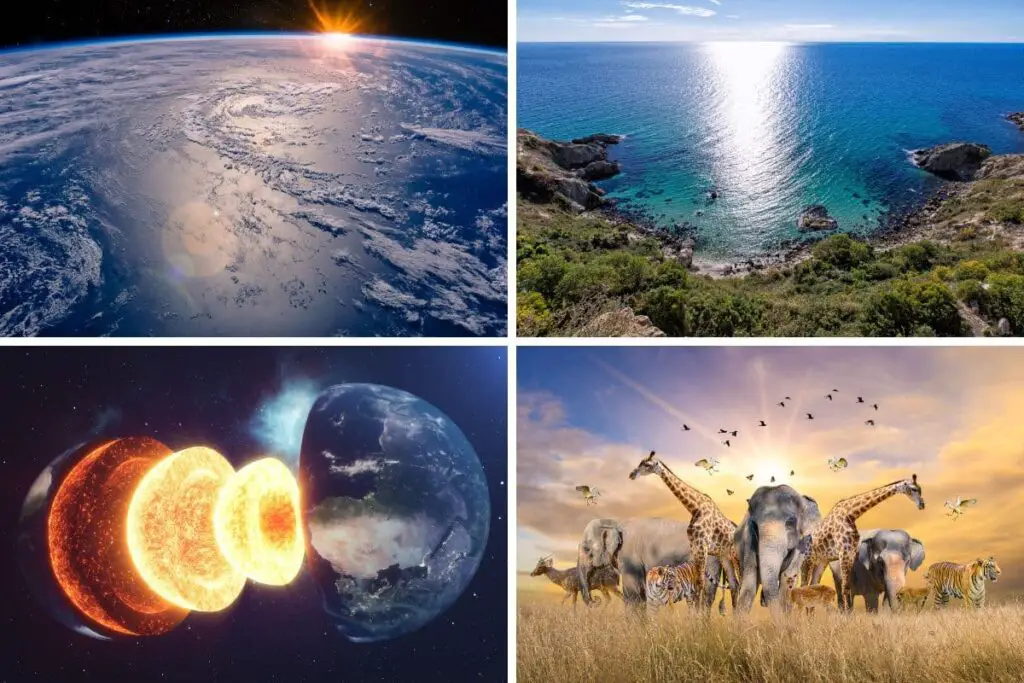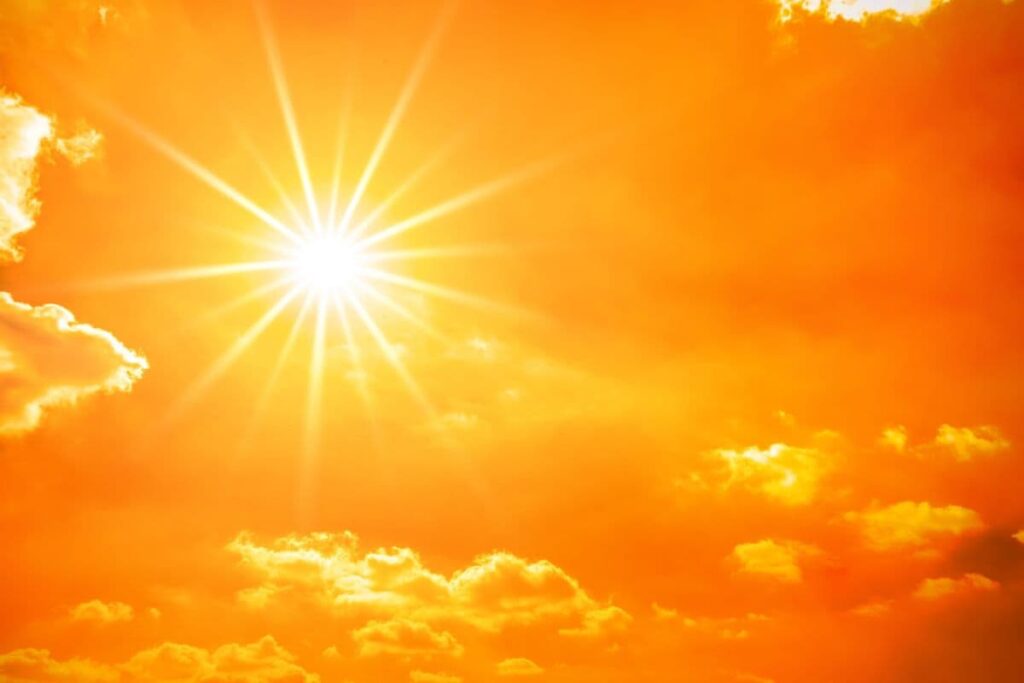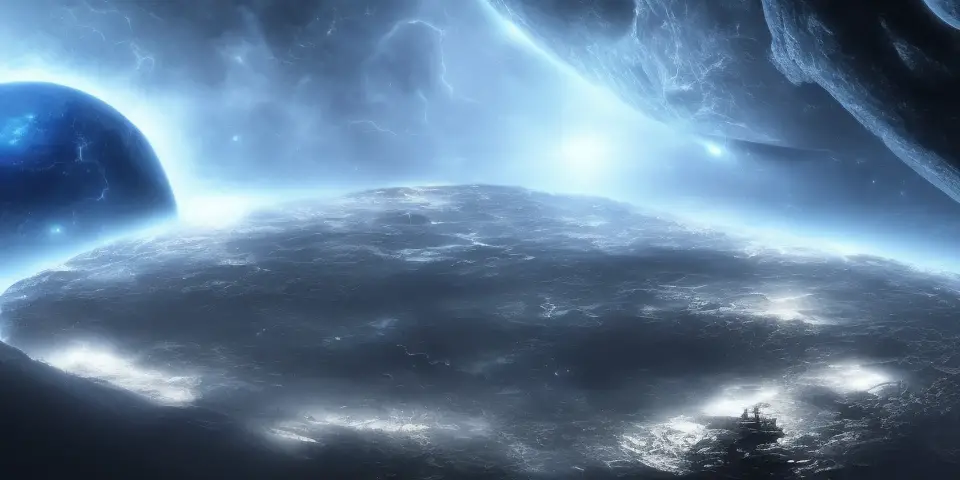|
Getting your Trinity Audio player ready...
|
Four types of environment exist on Earth, and each has a role to play in the spectacle of life. The components within each environment contribute to the survival of all organisms on Earth and dramatically impact our lives. Can you imagine the catastrophic events that would accompany the collapse of just one environment, like the hydrosphere as depicted in our featured image.
The four types of environment on Earth are the atmosphere, hydrosphere (aquatic), lithosphere (terrestrial), and biosphere. Important components of these environments include abiotic factors, such as air, water, and soil, and biotic elements, including plants, animals, and microorganisms.
Without the distinctive environments and their primary components, life on Earth wouldn’t look the way it does. We depend on these systems for survival. In this article we examine the four types of environment, their primary components, and how they are essential to life on Earth.
The Four Types of Environment

Atmospheric Environment
On a summer day, observe the vibrant blue skies and feathery white clouds. Feel the warm sunshine and cool breeze on your face. The sky, clouds, sunshine, and wind are all parts of Earth’s atmosphere.
The atmosphere makes up the protective, transparent shield surrounding the Earth. It acts as a filter to block dangerous ultraviolet radiation from the sun and provides pressure to produce liquid water. Additionally, the atmosphere allows Earth to stay warm enough to make the planet habitable.

The atmosphere is the most crucial environment, containing many components to sustain life. Much of life on Earth is in constant contact with the atmosphere, including humans.
Birds, insects, plants, fungi, and other microbial life utilise the atmosphere for travel. Insects and birds fly through the air, many plant species spread seeds by wind dispersal, and fungi release spores into the atmosphere.
The Hydrosphere (Aquatic Environment)
Whether you’re surfing in the ocean, canoeing on a river, or swimming in a lake, you’re utilising parts of Earth’s hydrosphere. The hydrosphere encompasses all aquatic bodies of all types of environments, from the saltiest seas to freshwater rivers.
- Wetlands
- Creeks
- Estuaries
- Underwater streams
- Water vapour in the atmosphere
The hydrosphere is a critical environment and performs vital functions necessary to sustain life on Earth. These functions include recycling nutrients, water purification, and maintenance of water flow.

Species that live in areas of the hydrosphere have developed adaptations allowing them to survive within an aquatic environment. For example, osmoregulation allows some marine organisms to maintain homeostasis by controlling the water and salt concentrations within their bodies.
Aquatic environments are very delicate systems. They’re susceptible to even the tiniest changes. Pollution, weather, and even sunlight (too much or too little) can significantly affect biodiversity within the hydrosphere.
Lithosphere (Terrestrial Environment)
From the redwood forests to the arctic tundras of the northern hemisphere, the lithosphere comprises all terrestrial environments on Earth. This type of environment encompasses all eight biomes:
- Arctic tundra
- Boreal forests
- Deserts
- Savannas
- Subtropical deserts
- Temperate grasslands
- Temperate forests
- Tropical rainforests
Different types of environments among biomes.
They depend on abiotic components, including the following:
- Weather and climate
- Soil structure
- Water composition
The lithosphere contains incredible numbers of diverse ecosystems. These organisms have developed over time to resist fluctuations such as sudden temperature changes and weather extremes through adaptations like:
- Hibernation
- Migration
- Production of feathers, hair, and fat
For example, the polar bears of the arctic regions have thick layers of fat that insulate their bodies to protect them from the freezing air. Another example of terrestrial adaptation is air-breathing organisms. They breathe slower than aquatic species because the atmosphere has a greater oxygen concentration than water.
Biospheric Environment
The biosphere is the environment that encompasses all living things on every corner of the planet. There is life from the harshest ocean trenches to the coldest mountain peaks. Life occurs in every sphere: the atmosphere, lithosphere, and hydrosphere.
The biosphere extends over every biome.
The Environment’s Four Main Components
Each type of environment is made up of main components.
Air
Air is the main component of the atmospheric environment. It primarily comprises oxygen and nitrogen, with carbon dioxide making up around 0.04 per cent. Other gases include argon, methane, neon, and helium.
Atmospheric conditions can affect all environments on Earth. Climate can have long-term impacts, whereas weather creates short-term changes in different environments.
Short-Term Weather Changes
Raindrops may collect pollutants from the atmosphere generated by human civilisation. A bout of heavy rain could bring those chemicals to the ground, raising the soil’s pH for a short period. This process can kill flora, resulting in the loss of fauna that relies on flora for survival. However, once the heavy rainfall ceases, things become balanced again.
Chemicals within the atmosphere can also dissolve in the hydrosphere, affecting the clarity and quality of aquatic environments, and significantly impacting biodiversity.
Long-Term Climate Changes
Climate change can dramatically affect entire landscapes and ecosystems, transforming one biome into another. If a temperate forest experiences consistent rising temperatures and lower precipitation rates, it could become a desert within hundreds of years.
Water
Water is the main component of the hydrospheric environment. One can also find it in the atmospheric environment as water vapour.
The chemical formula for water is H2O. There are dissolved chemicals in the water that come from both the atmospheric and lithospheric environments. In freshwater environments, these dissolved solids comprise the following:
- Calcium
- Magnesium
- Sodium
- Ammonium
- Hydrogen
In marine or saltwater environments, the most abundant salts include:
- Chloride
- Sodium
- Sulfate
- Magnesium
- Calcium
- Potassium
Several factors affect the biodiversity of water:
- Freshwater or seawater
- Stationary or moving
- Chemical composition
- Temperature
- Depth
Water plays a critical role in all environments because the flora and fauna on Earth are affected by water.
Rocks & Soil
The main component of the lithosphere is soil. The lithosphere also contains rocks, sand, and minerals. However, all of these fall under the umbrella of soil because soil comprises microscopic rocks and minerals.
Soil has a high level of diversity, which is affected by the type of environment and multiple other factors:
- Climate/weather
- Organisms within the soil
- Topography
- Soil structure (loam, clay, sand)
We relate the richness of soil to biotic factors. For example, a defining characteristic of freshwater wetlands is their rich soil and incredible biodiversity. On the contrary, tundras, with their frigid conditions and low-quality soil, feature low levels of biodiversity.
Soil structures play a vital role in nutrient concentrations. Clay soils, for example, are dense, so they hold on to more moisture and nutrients. Sand is more porous. Water and nutrients flow through (and away from) sand with ease.
Moisture directly affects flora and fauna within the soil, which is why species develop adaptations to their environment.
Take the Namib Desert Beetle, for example. It thrives in the Namib Desert, which receives around 1.4 centimetres (0.55 inches) of annual rainfall. To survive, the beetle comes out of hiding in the foggy dawn hours and slants its hard body towards the wind. The fog condenses on its back and slides down into its mouth.
Biological Element
The biological components of the Earth make up the biosphere. These components include all living things within every ecosystem; plants, animals, and microorganisms.
Three biotic (living) components make up every ecosystem in the biosphere. They are:
- Producers
- Consumers—herbivores, carnivores, omnivores
- Decomposers
These biotic components are part of three categories: autotrophs, heterotrophs, or detritivores.
Autotrophs (Producers)
The autotrophs are the beginning of life, the fundamental unit on which all life depends. Without the producers, the rest of the ecosystem would cease to exist. Autotrophs create their food and are the green plants and algae of the Earth. Most of these producers make sugars through photosynthesis or chemosynthesis.
Consumers (heterotrophs) and decomposers (detritivores) depend on energy received from consuming producers.
Heterotrophs (Consumers)
Most of the world’s biodiversity comprises heterotrophs. These are the herbivores, carnivores, and omnivores. They do not create their food and, instead, rely on the consumption of producers and other heterotrophs for nourishment and energy. They eat complex organisms such as plants and animals instead of synthesising nutrients through photosynthesis or chemosynthesis.
From microscopic bacteria to a large grizzly bear, one will find heterotrophs in all types of environments across the planet.
Detritivores (Decomposers)
Though detritivores are decomposers, they’re also consumers. However, they feed on dead organic material, giving them a separate classification. They break down dead matter to receive energy.
From earthworms and fungi to dung beetles and fiddler crabs, detritivores complete the cycle of life. They “pick up” after producers and consumers, break down their waste, and serve as a food source.
Final Thoughts
We share this dazzling blue globe with many living creatures, as well as many non-living components. All of them play a critical role in the circle of life and how we exist in this world.
The growth and evolution of all organisms depends on environmental influences and their components. From the sunshine in the sky to the earthworms in the soil, these things make our world habitable—a place we can call home.

